Through dynamic tales, the Bible's action-packed narratives offer timeless lessons on courage and faith, inviting readers to discover their contemporary relevance.
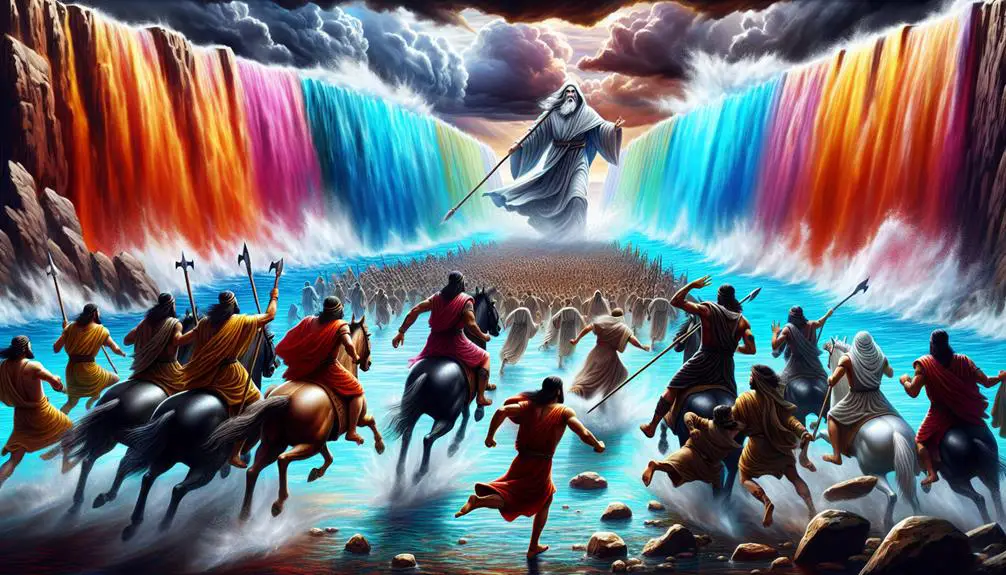
Action in the Bible
Have you ever considered the possibility that the action-packed stories in the Bible aren't just historical accounts, but also lessons in courage, faith, and determination?
From David's bold confrontation with Goliath to Moses parting the Red Sea, these narratives aren't merely for entertainment; they serve a deeper purpose.
As you explore these tales, think about the underlying messages they convey and how they apply to modern-day challenges.
What if these stories are more than ancient history, offering actionable insights for today's world?
Let's uncover the hidden wisdom in these biblical actions together.
Key Takeaways
- Biblical narratives often depict action as a manifestation of faith and divine intervention.
- Stories of triumph, like David versus Goliath, symbolize overcoming obstacles through belief and righteousness.
- Survival tales, such as Paul's shipwreck, highlight resilience, human determination, and the presence of a guiding higher power.
- Leadership and community are crucial in facing adversity, as seen in narratives of divine guidance uniting and inspiring individuals.
David Vs. Goliath: a Defining Battle
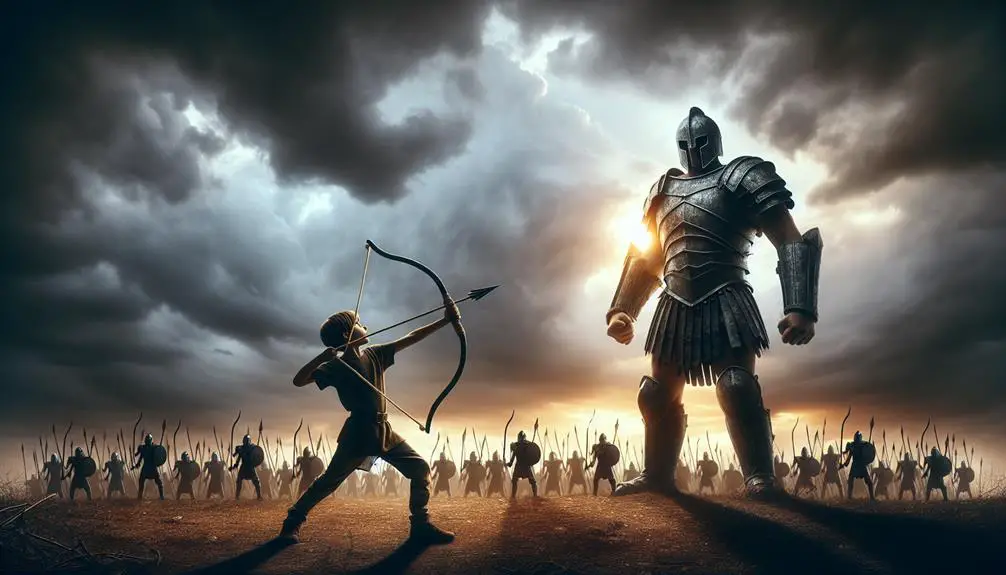
In the tale of David vs. Goliath, we witness a quintessential battle that not only showcases the triumph of the underdog but also encapsulates the enduring themes of faith, courage, and divine intervention in biblical narratives. This story is pivotal, as it serves as a metaphor for overcoming seemingly insurmountable odds through belief and the support of a higher power.
The symbolism of Goliath as a giant extends beyond his physical stature, representing formidable challenges or oppressors that one might face in life. His defeat by David, a young shepherd with no military training, underscores the theme of underdog victory, emphasizing that strength and victory aren't always determined by size or power but by the righteousness of one's cause and the support of divine forces.
Analyzing this narrative, you find that it also challenges the conventional wisdom of the time, suggesting that faith and moral integrity can triumph over brute force and intimidation. David's victory isn't just a personal achievement but a communal one, uplifting the spirits and faith of the entire nation of Israel.
Moreover, the story of David and Goliath underlines the importance of divine intervention in biblical accounts. David's success is attributed to his unwavering faith in God, who guides and supports him through the battle. This aspect of the narrative reinforces the belief that with divine guidance, any challenge can be overcome, no matter how daunting it may seem.
In essence, the battle between David and Goliath is a profound lesson in faith, courage, and the power of divine assistance, encapsulating the essence of underdog victory and the symbolism of giants as formidable challenges to be overcome.
Moses Parts the Red Sea
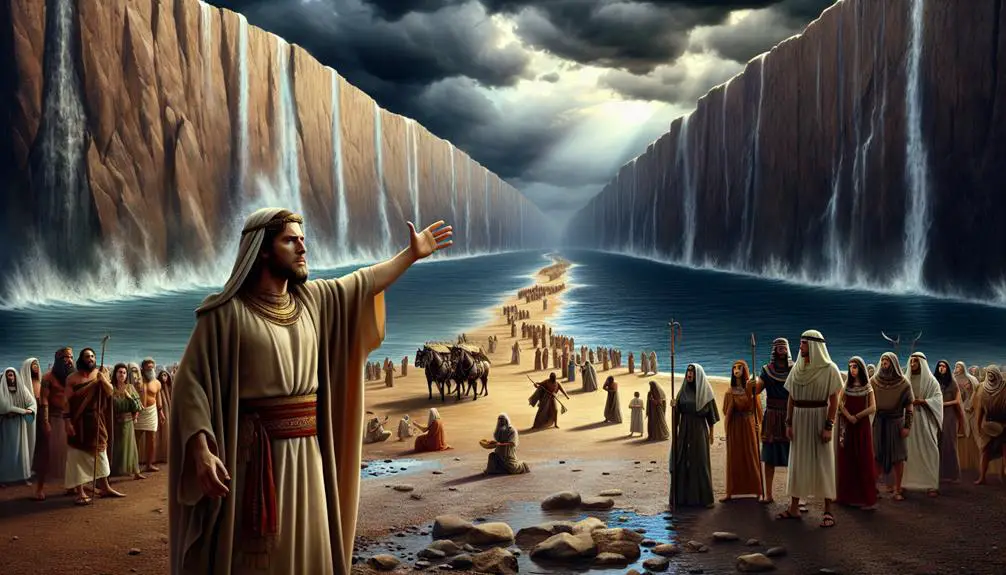
Much like David's victory brought a new dawn for Israel, Moses parting the Red Sea symbolizes a pivotal moment of deliverance and divine power in the Bible. This event isn't just a tale of escape; it's a profound demonstration of faith's power and divine intervention acting in harmony. As you delve into the narrative, you recognize its layers, unraveling the complexity of human faith intertwined with the certainty of divine will.
Here are three key aspects to consider:
- The Immediacy of Divine Intervention: Unlike other biblical narratives where divine intervention unfolds gradually, here, it's immediate and awe-inspiring. Moses stretches out his hand over the sea, and God parts the waters—a direct and powerful response to Moses' act of faith.
- The Test of Faith: The Israelites' journey to the Red Sea is a test of faith, both for Moses and his followers. Facing the sea ahead and the Egyptian army behind, their situation seems insurmountable. Yet, Moses' unwavering faith in God's promise guides them through.
- A Symbol of Deliverance: The parting and subsequent crossing of the Red Sea serve as a profound symbol of deliverance. It represents the transition from slavery to freedom, from despair to hope, and from doubt to faith.
In analyzing Moses' parting of the Red Sea, you're invited to explore the depths of faith's power and the certainty of divine intervention. This narrative doesn't merely recount a miraculous escape; it offers a timeless lesson on the dynamics of faith and divine aid in overcoming seemingly impossible obstacles.
The Fall of Jericho
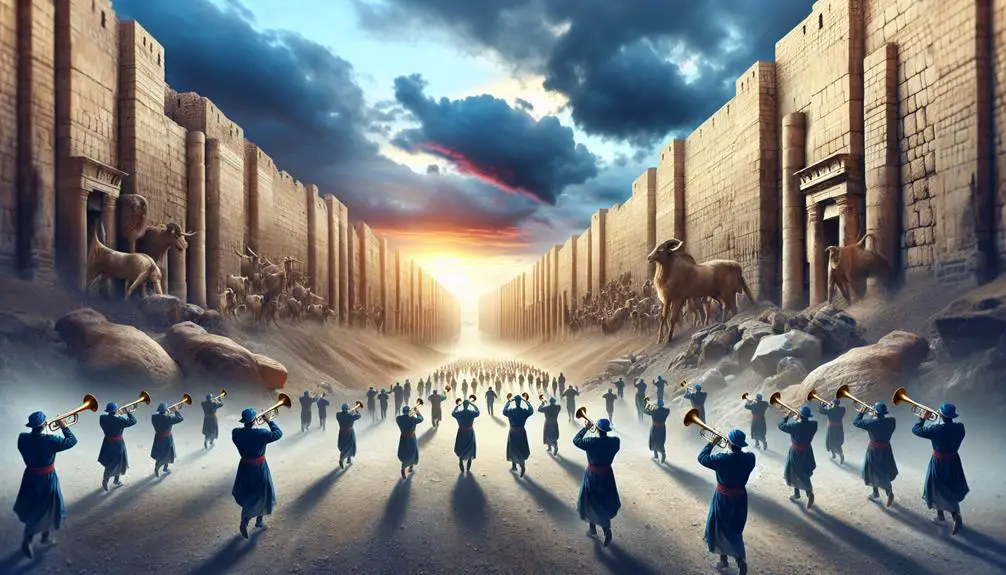
The fall of Jericho stands as a testament to the power of faith and obedience, marking a significant moment in Israel's journey to claim the Promised Land. This event, immortalized in the Hebrew Bible, showcases not just a miraculous military conquest but also underscores the pivotal role of divine intervention in achieving what seems impossible by human standards.
Analyzing the narrative, you can't overlook the unprecedented strategy that led to the collapse of Jericho's walls. The Israelites' approach, involving the march around the city for seven days, followed by the use of trumpets and a collective shout, diverges radically from conventional siege tactics. This method, devoid of any apparent military logic, highlights a profound reliance on spiritual guidance over martial prowess.
Furthermore, Rahab's role injects a fascinating layer of complexity into the story. Her actions, driven by faith in the God of Israel, not only provide the Israelite spies with crucial intelligence but also ensure her family's survival amidst the city's destruction. Rahab's inclusion in the narrative exemplifies the theme of redemption and the inclusive nature of divine promise, extending beyond the ethnic and cultural boundaries of Israel.
The fall of Jericho, therefore, isn't merely a tale of ancient warfare. It's a rich, multi-dimensional account that speaks to the themes of faith, obedience, and the universality of salvation. It invites you to ponder the depths of faith required to follow seemingly irrational divine instructions, and the unexpected ways in which faithfulness can be rewarded.
Daniel in the Lion's Den

Diving into the narrative of Daniel in the Lion's Den reveals a profound exploration of faith under duress, showcasing how unwavering belief in God's protection can transcend the deadliest threats. This story, rich in lion symbolism and the theme of faith under trial, offers a multi-layered analysis of how individuals can stand firm in their beliefs amidst potentially fatal challenges.
To draw you into the depths of this narrative, consider the following aspects:
- Lion Symbolism: The lion, often regarded as the king of beasts, symbolizes supreme strength, authority, and fear. In this context, the lions represent not just physical danger but also the overwhelming power of Daniel's adversaries who sought to undermine his steadfast faith. Yet, his survival turns these predators into symbols of God's dominion over all earthly powers.
- Faith Under Trial: Daniel's ordeal in the lion's den is a testament to the power of faith. His refusal to renounce his devotion to God, even when faced with death, underscores the narrative's core message: faith tested is faith strengthened. This episode illustrates that true belief isn't passive but an active trust in God's deliverance, regardless of the circumstances.
- Divine Intervention: The miraculous closing of the lions' mouths serves as a powerful affirmation of divine intervention. It highlights that when human capabilities end, God's power begins, showcasing the divine as the ultimate protector of the faithful.
In dissecting Daniel in the Lion's Den, you encounter a timeless narrative that illustrates the triumph of faith over fear and divine sovereignty over human predicaments. This story not only enriches one's understanding of biblical themes but also offers insight into the enduring human spirit when anchored by belief in a higher power.
Peter Walks on Water
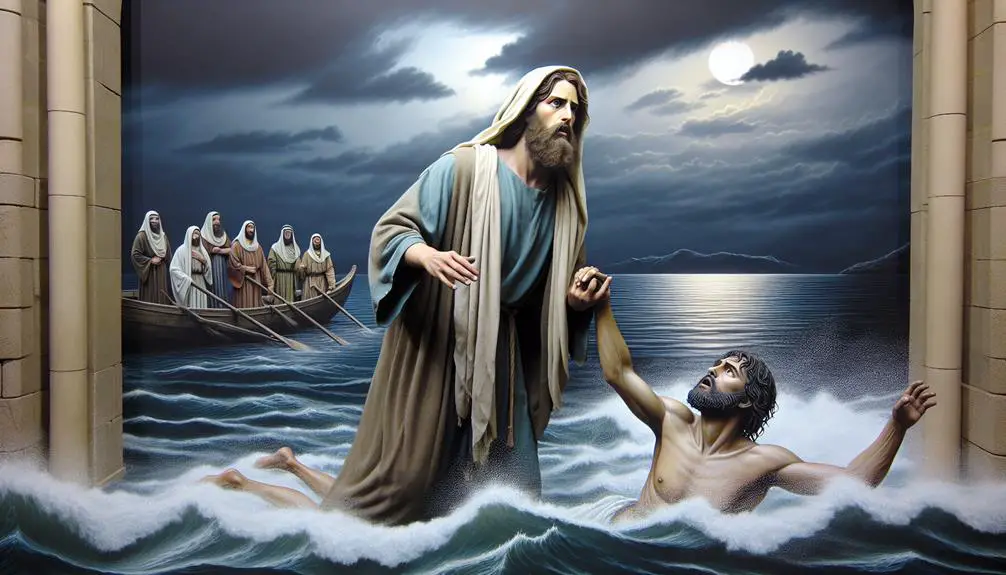
Shifting our focus from the terrestrial trials of Daniel to the aqueous faith challenge faced by Peter, we encounter another compelling example of divine intervention and the potency of belief. This narrative, commonly known as Peter's walk on water, underscores a pivotal moment in the New Testament, offering profound insights into the dynamics of faith and doubt within the context of water miracles.
You'll find that at the heart of this story lies Faith's Leap—a concept illustrating the transition from fear to faith. Peter, upon seeing Jesus walking on water, initially exhibits an unyielding belief by stepping out of the boat. This act itself encapsulates a dual facet of human nature: the courage to confront the unknown and the susceptibility to falter under the weight of doubt.
Analyzing further, the water miracle here isn't just an exhibition of Christ's dominion over nature but serves as a metaphorical canvas, reflecting the tempestuous seas of life where faith can either anchor us or, in its absence, lead to our sinking. It's the momentary lapse in Peter's conviction, as he notices the wind, that underscores the fragility of human faith when faced with adversity.
Moreover, the immediate rescue by Jesus, following Peter's plea, illuminates another critical facet: divine grace. It's a testament to the notion that while human faith may waver, the divine promise of support remains steadfast.
In essence, Peter's walk on water transcends the literal to embody the essence of Faith's Leap, offering an enduring lesson on the interplay between belief, doubt, and divine grace within the realm of water miracles.
Paul's Shipwreck Survival
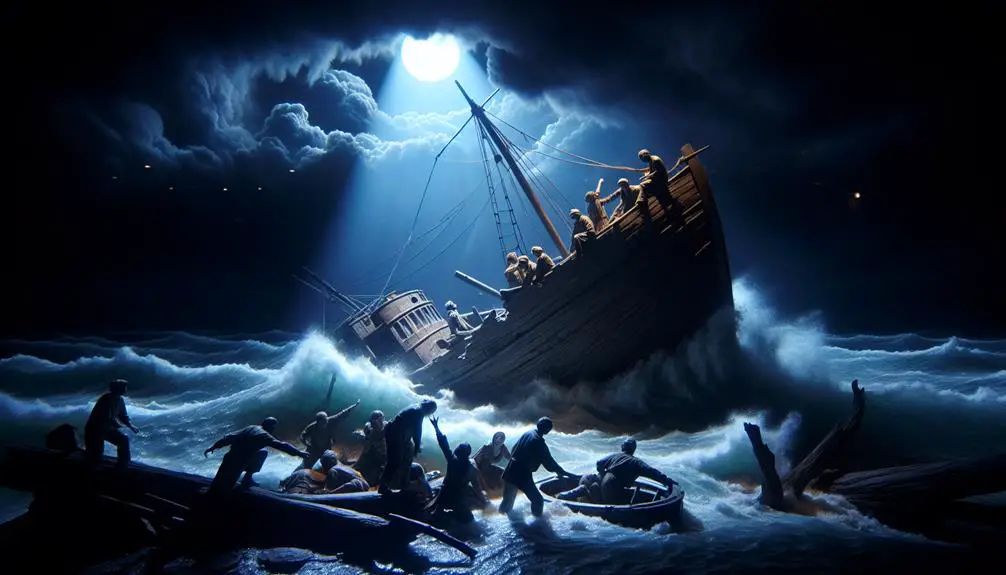
Embarking on a perilous journey, Paul's shipwreck survival story serves as a profound exploration of resilience and divine providence amidst adversity. This narrative, rich in historical and theological significance, offers you a unique lens through which to view survival strategies and ancient navigation techniques. It's a tale that not only highlights human determination but also underscores the intervention of a higher power in guiding and protecting individuals through the most daunting challenges.
To keep you engaged, consider these critical aspects of Paul's survival story:
- Ancient Navigation Techniques: The account provides insight into ancient maritime practices, including the reliance on stars for navigation and the use of primitive yet effective methods to gauge weather conditions. These ancient navigation skills were crucial for Paul and his companions as they navigated the treacherous Mediterranean.
- Divine Intervention: The narrative emphasizes the role of faith and divine intervention. Paul's unwavering belief in his divine mission and the assurances given to him through visions played a pivotal role in the morale of those aboard the ship.
- Community and Leadership: Paul's leadership and his ability to inspire and unify the ship's crew and passengers underscore the importance of strong communal ties and effective leadership in overcoming adversity.
Analyzing Paul's shipwreck survival, we uncover not only the survival strategies employed during ancient times but also the profound impact of spiritual faith and leadership in navigating life's storms. This story transcends its historical context, offering timeless lessons on resilience, guidance, and the power of belief in the face of overwhelming odds.
Frequently Asked Questions
How Do Biblical Accounts of Action Reflect on the Daily Lives and Moral Choices of Believers Today?
You are examining how stories of decision-making and behavior influence modern ethics and societal norms.
These narratives offer insights into ethical dilemmas, showcasing the complexity of moral choices.
Your analysis reveals their profound cultural impact, shaping beliefs and actions today.
In What Ways Do Modern Archaeologists and Historians Validate or Challenge the Miraculous Events Depicted in These Bible Stories?
You'll find modern archaeologists and historians often use historical methodology and geographical evidence to either support or question the miraculous events depicted in ancient texts. By analyzing artifacts, inscriptions, and location contexts, they provide insights that can validate or challenge traditional narratives.
Their work doesn't just add depth to our understanding; it also sparks debates on the authenticity and interpretation of these stories, pushing you to think critically about historical and spiritual claims.
How Have Various Christian Denominations Interpreted the Symbolism Behind These Action-Filled Events Differently?
You're diving into how different Christian groups parse symbolism, where denominational rituals and symbolic interpretations offer a mosaic of belief.
As you peel back layers, you find Catholics might see sacramental echoes where Protestants discern moral lessons. It's a rich tapestry where each thread represents a distinct understanding, revealing the diversity within unity.
This analytical journey showcases how deeply symbolism is woven into the fabric of faith, offering numerous paths to divine insight.
What Role Do These Stories of Action Play in the Broader Theological Discussions About Faith, Doubt, and Divine Intervention?
You're delving into how narratives of action shape theological debates on faith, doubt, and divine intervention.
These stories aren't just thrilling accounts; they're crucial for understanding divine mystery and the evolution of faith.
They push you to question and deepen your beliefs, offering a lens through which to view divine intervention in human affairs.
Analyzing these narratives helps unravel the complex relationship between faith's development and the interpretation of divine actions.
Can Parallels Be Drawn Between the Actions of Biblical Heroes and Contemporary Figures in Terms of Leadership, Courage, and Faith?
You can certainly draw parallels between historic leadership in biblical narratives and that of contemporary figures. By examining the ethical parallels, you'll find that both sets of leaders often embody courage, faith, and a commitment to their cause.
This comparison offers rich insights into how timeless principles of leadership and moral courage transcend cultural and temporal boundaries, providing lessons on leadership that remain relevant in today's complex societal landscape.
Conclusion
In analyzing these biblical narratives, it's evident that action isn't merely a backdrop but a catalyst for faith and transformation. Consider David's confrontation with Goliath; it wasn't just a battle but a testament to the power of belief over brute strength.
These stories, steeped in dramatic action, aren't just ancient texts but resonate with timeless lessons on courage, faith, and resilience. They challenge us to see beyond the immediate, urging a deeper reflection on our struggles and triumphs.



Sign up